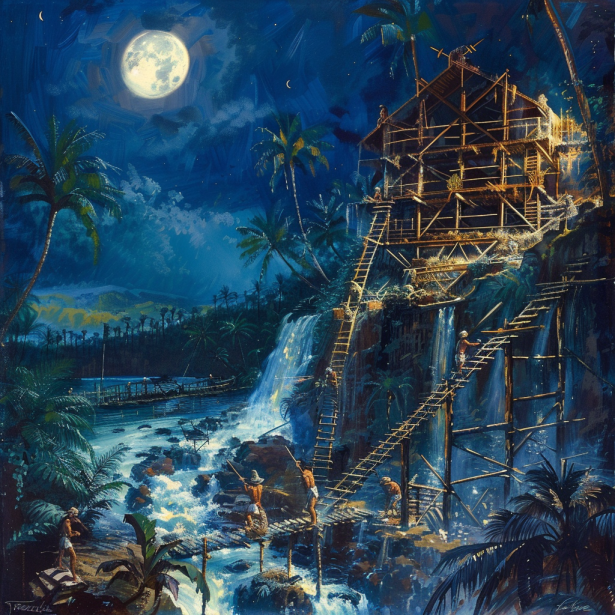Introduction
In Hawaiian tradition, the Menehune are legendary small people, often compared to leprechauns. These mythical beings are said to be skilled craftsmen and builders, responsible for constructing fishponds, temples, and other structures overnight. While traditionally considered folklore, some claim there is archaeological evidence supporting the existence of the Menehune, pointing to ancient structures like the Alekoko Fishpond on Kauai. The mysterious and elusive nature of the Menehune continues to fascinate locals and visitors alike, blurring the lines between myth and reality.
Legends of the Menehune
Origins and Descriptions
- Traditional Beliefs: According to Hawaiian mythology, the Menehune were a race of small people who lived in Hawaii before the Polynesians arrived. They were known for their exceptional skills in building and crafting.
- Physical Characteristics: The Menehune are often depicted as being around two to three feet tall, with a stocky build. They are said to have lived deep in the forests and hidden valleys, coming out only at night to perform their feats of construction.
Notable Legends
- Alekoko Fishpond (Menehune Fishpond): One of the most famous structures attributed to the Menehune is the Alekoko Fishpond on the island of Kauai. Legend has it that the Menehune built the fishpond in a single night, passing stones hand-to-hand over a great distance.
- Other Constructions: The Menehune are also credited with constructing other impressive structures, such as heiau (temples), irrigation ditches, and roads, all supposedly built under the cover of darkness to avoid detection by humans.
Archaeological Evidence
Alekoko Fishpond
- Historical Significance: The Alekoko Fishpond, also known as Menehune Fishpond, is an ancient aquaculture system designed to cultivate fish. It is a marvel of engineering, featuring walls up to five feet high and 900 feet long.
- Construction Techniques: The precise methods used to build the fishpond remain a mystery, but the legend of the Menehune suggests advanced knowledge and techniques far beyond what was common at the time.
Other Structures
- Niumalu Temple: Another structure attributed to the Menehune is the Niumalu Temple, which also showcases advanced construction techniques that have intrigued archaeologists.
- Irrigation Canals: There are ancient irrigation canals on various Hawaiian islands that some believe were built by the Menehune, further supporting the idea that they were skilled engineers.
Debates and Theories
Myth or Reality?
- Folklore Perspective: Many scholars argue that the Menehune are purely mythical, serving as cultural stories that explain the origins of impressive ancient structures.
- Evidence-Based Perspective: Some researchers and locals believe that the Menehune could have been an actual race of people, possibly an early wave of settlers who predated the Polynesians.
Possible Explanations
- Early Inhabitants Theory: One theory suggests that the Menehune were the remnants of an early Polynesian or pre-Polynesian group who lived in Hawaii before the main wave of settlers arrived. They may have been smaller in stature and more reclusive, giving rise to the legends.
- Cultural Memory: Another theory is that the Menehune represent a cultural memory of an older society that possessed advanced building techniques, which were later attributed to mythical beings as the stories were passed down through generations.
Cultural Impact
Modern Hawaiian Culture
- Cultural Symbolism: The Menehune have become a significant part of Hawaiian culture, symbolizing the islands’ rich history and the blending of myth and reality.
- Tourism and Education: The legends of the Menehune attract tourists and are used in educational contexts to teach about Hawaiian mythology and history.
Pop Culture
- Media Representation: The Menehune have appeared in various forms of media, including books, movies, and television shows, further embedding them into popular culture.
- Merchandise and Souvenirs: From Menehune dolls to themed tours, the commercial aspect of the legend continues to thrive, contributing to the local economy.
Conclusion
The Menehune of Hawaii remain one of the most captivating aspects of Hawaiian mythology. Whether they are purely mythical or based on historical facts, their stories continue to enchant and intrigue. The blend of legend and potential reality in the form of archaeological evidence like the Alekoko Fishpond adds depth to the cultural tapestry of Hawaii. As researchers and enthusiasts continue to explore these mysteries, the Menehune will undoubtedly remain a fascinating topic for generations to come.
FAQs
Who are the Menehune in Hawaiian tradition?
The Menehune are legendary small people in Hawaiian mythology, known for their exceptional skills in building and crafting. They are said to have lived in Hawaii before the arrival of the Polynesians.
What structures are attributed to the Menehune?
The Menehune are credited with building various structures, including the Alekoko Fishpond, heiau (temples), irrigation ditches, and roads, often said to have been constructed overnight.
Is there archaeological evidence supporting the existence of the Menehune?
Some believe that ancient structures like the Alekoko Fishpond on Kauai provide evidence of the Menehune’s existence, though this remains a topic of debate among scholars.
What are some theories about the Menehune?
Theories about the Menehune range from them being purely mythical beings to being an early wave of settlers or an older society with advanced building techniques.
How do the Menehune influence modern Hawaiian culture?
The Menehune are an integral part of Hawaiian culture, symbolizing the islands’ rich history and mythological heritage. They also attract tourists and are featured in various forms of media and merchandise.
Why do the legends of the Menehune persist?
The legends persist due to their deep cultural roots, the mystery surrounding their possible existence, and the fascination with ancient Hawaiian history and mythology.

